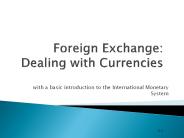The Foreign Exchange Reserves Buildup: Business as Usual? - PowerPoint PPT Presentation
Title:
The Foreign Exchange Reserves Buildup: Business as Usual?
Description:
The Foreign Exchange Reserves Buildup: Business as Usual? Charles Wyplosz Graduate Institute of International Economics and CEPR Workshop on Debt, Finance and ... – PowerPoint PPT presentation
Number of Views:194
Avg rating:3.0/5.0
Title: The Foreign Exchange Reserves Buildup: Business as Usual?
1
The Foreign Exchange Reserves Buildup Business
as Usual?
- Charles Wyplosz
- Graduate Institute of International Economics
- and CEPR
- Workshop on Debt, Finance and Emerging Issues
- in Financial Integration, 6-7 March 2007
2
The issue
Excessive?
3
Need to answer two questions
- Measurement
- Criteria
- Both related to motive
4
Measurement
- Nominal reserve stocks
- Usual scale variables
- GDP
- Trade (imports, exports)
5
Measurement
- Nominal reserve stocks
- Usual scale variables
- GDP
- Trade (imports, exports)
- Popular rules
- 3 months of imports
- Stock of short-term external liabilities
- Greenspan-Guidotti-Fischer rule
6
A different picture
Excessive?
7
The impact of financial globalization
8
More details Who does it?
9
More details Who does it and why?
10
And some outliers
11
Excessive?
- The motives approach
- The cost-benefit approach
12
Motives
- Self-insurance
- Shifting risks
- from trade balance to capital account
- from 3 months of imports to Greenspan-Guidotti-Fis
cher rule - Mercantilism
- Variant 1 Export-led growth strategy
- Variant 2 Keep savings home
- Variant 3 Hold reserves for the sake of it
- Variant 4 Directed credit
13
Testing motives
- Aizenman and Lee (2006)
- Strong effect of variables related to
self-insurance - Capital account liberalization
- Crisis dummies
- Some effect of variables related to mercantlism,
but much weaker - Undervaluation
- Export growth
14
Testing motives
- Aizenman and Lee (2006)
- Jeanne and Rancière (2006)
- Model of self-insurance
- Reserve build-up well explained
- But some outliers in South-East Asia
15
Testing motives
- Aizenman and Lee (2006)
- Jeanne and Rancière (2006)
- Official and unofficial statements
- Conclusion self-insurance and fear of IMF
16
Costs and benefits
- Costs
- Direct costs
- Rodrik (2006) 1 of GDP for reserves 30 of GDP
- Opportunity costs
- Better returns at home (private and public)
- The case of China
17
Costs and benefits
- Costs
- Benefits
- Export-led growth
- Self-insurance
18
Export-led growth
- Apparently successful, so a benefit?
- Only if systematic undervaluation works
- No evidence that it does
- No theory
- Nominal vs. real exchange rate
- Strong foreign demand inflation
- Unless domestic demand is weak
- High saving is the key success factor
- But then what to do with the savings?
- Invest at home or abroad
19
Self-insurance
- Currency crises can be very expensive
- A good reason to buy insurance
- Do high reserve stocks provide insurance?
- Not really an insurance
- Reduce the odds of crisis
- Unlikely to eliminate the threat
- False sense of immunity
- Could discourage reforms
- Could encourage imprudent policies
20
Wrap-up
- Limited evidence of excessive accumulation
- Some prominent exceptions
- Little evidence of mercantilist motive
- Mostly self insurance
- Recent build-up is business as usual
- What has been unusual is financial gloablization































